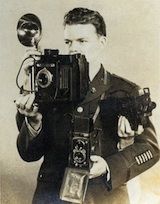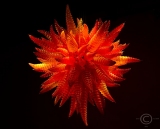- Forum
- General Discussion | Introductions | Off Topic Forum
- Photography General Discussion
- In the days of the darkroom....
In the days of the darkroom....
-

- MLKstudios
- Banned
-
- D800 ;-)
- Followers: 72
- Posts: 4480
-
Points:
2
Post #80111
The paper we used (for black and white) is "orthochromatic" or not sensitive to red wavelengths (of light). So we could turn on a red light and were able to see what we were doing without fogging the paper.
Matthew
Matthew L Kees
MLK Studios Photography School
www.MLKstudios.com
[email protected]
"Every artist, was once an amateur"
-

- cod
- Snapobsessed
- Nikon D300S
- Followers: 71
- Posts: 484
-
Points:
1165
Post #80115
-

- Henry Peach
- Apprentice
-
- I currently use a 5DII or Sony Nex-3 most of the time.
- Followers: 50
- Posts: 2925
-
Points:
16
Post #80461
Once I was locked in my darkroom with my hands full of sheets of 4x5 film I was tray developing. It was pitch black. Something began chewing loudly behind me. I just had to sit in the dark shuffling the film, and hoping it wasn't coming for me next. I never could figure out what it was or what it was eating when the lights came on. It happened several times over the course of a week, and then whatever it was moved on.
-

- MLKstudios
- Banned
-
- D800 ;-)
- Followers: 72
- Posts: 4480
-
Points:
2
Post #80465
Matthew L Kees
MLK Studios Photography School
www.MLKstudios.com
[email protected]
"Every artist, was once an amateur"
Post #80515
With newer multigrade papers I'm not sure if it matters so much for basic black and white; I was using a darkroom at a local university that started phasing out that program (which is why I'm collecting items to set up my own darkroom) and I think it had an amber satelight in the part of the darkroom w/the print stations. So we could see and not run into each other going from the enlarger to the sink!
When I started out there taking a weeklong workshop we were learning how to develop film and were standing in the pitch dark passing a can opener to the next person so we could each pop open our film canisters. (Later I was like - can't the university spring for a couple more $1 can openers??)
Sharon
-

- effron
- Newbie
- Followers: 1623
-
Points:
129640
Post #80539
goli wrote: I understand the reason for no lights.. but what was the reason for having a red light? Was it only to see? or did it help develop the film?
Hell, I know I had a red light, but that was a long time ago....
The above are correct, only B&W printing, everything else in the complete dark.......
Why so serious?
-

- John Landolfi
- Super User
-
- Nikon D3S, D7100, Sony RX10, Canon G11, F4s, F2sb, RetinaflexIV etc, etc
- Followers: 1205
- Posts: 21605
-
Points:
40394
Post #80557
-

- Graflex 4x5
- Lone Wolf
-
- Nikon D300
- Followers: 4
- Posts: 178
-
Points:
0
Post #80643
Kodak stopped making their ortho films a while ago, but ADOX and Rolli are making film in 35 mm, 70 mm and 4 x 5 cut film. And if you can find a doctor or hospital that hasn't gone digital, X-ray films are ortho.
No matter how fast I go, there's always someone slower in front of me.
-

- Henry Peach
- Apprentice
-
- I currently use a 5DII or Sony Nex-3 most of the time.
- Followers: 50
- Posts: 2925
-
Points:
16
Post #80969
Graflex 4x5 wrote: ...but 'back in the day' there were orthochromatic films...
Sure, there are always exceptions to the norm. Pyro developers use a dim green light to inspect film development. My darkroom safelights are mid-20th century Kodak brand models. They came with dozens of different filters.
- Forum
- General Discussion | Introductions | Off Topic Forum
- Photography General Discussion
- In the days of the darkroom....
Latest Reviews
The Fujifilm XT5 is a 40MP mirrorless camera capable of 6.2K video at 30p. With those specs, it’s an ideal choice for photographers needing a camera to pull double duty for imaging and video.
The Canon EOS R100 is an entry-level mirrorless camera introduced in 2023. But just because it’s an entry-level camera doesn’t mean it’s a bare-bones camera. Find out why in this review!
Nikon’s retro-looking Nikon Zfc is anything but retro. Under its classic body is a host of features and amenities that make it a worthwhile compact mirrorless camera for 2024.
The Canon EOS R50 is one of the newest R-system cameras from Canon. Is it worth your money? Find out all the details you need to know in this comprehensive review.
Forum Top Posters
-
1TCav 9 posts
-
2CharleyL 5 posts
-
3Sawyer 5 posts
-
4AstralArti... 3 posts
-
5Jason Stevens 3 posts
-
6db3348 3 posts
-
7Stanly 3 posts
-
8Randy Shaw 3 posts
-
9Razky 3 posts
-
10Moe 3 posts
Latest Articles
Urban photography is a genre showcasing features in urban settings. You can photograph people, architecture, mass transit, and many other subjects. Learn how to do so in this guide!
The Nikon D850 might be an older DSLR, but it was ahead of its time when it debuted in 2017. That means it still has plenty of firepower to compete with today’s powerful mirrorless cameras.
The best beginner camera isn’t the same for everyone. That means having choice is of the utmost importance. In this guide, explore five excellent beginner camera options for 2024 and beyond.
Child portrait photography is a unique undertaking requiring special skills and talents to get the best results. Start mastering this photography niche with these essential tips!
The Fujifilm XT5 is a 40MP mirrorless camera capable of 6.2K video at 30p. With those specs, it’s an ideal choice for photographers needing a camera to pull double duty for imaging and video.
Using leading lines in photography helps improve the composition by drawing viewers in and leading their eye from the foreground to the background. Explore some fine examples of this in this guide!
The Insta360 has one of the best lineups of action cams and 360-degree cameras. With these Insta360 accessories, you can elevate your photography and videography game!
Creating impactful photos of landscapes depends on many factors, not the least of which is your talent behind the lens. This guide explores other elements required for the best product.














